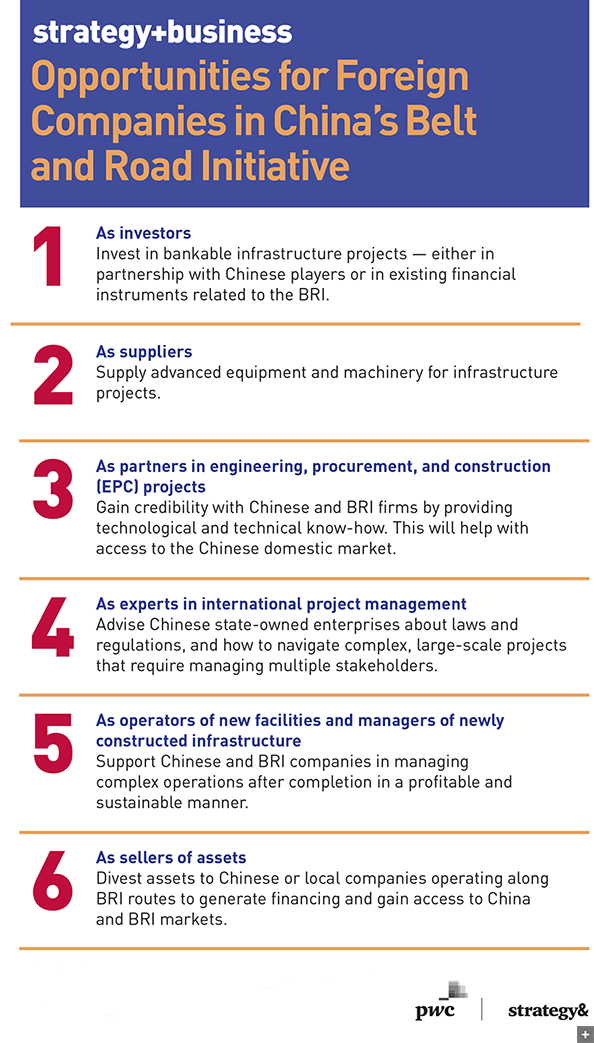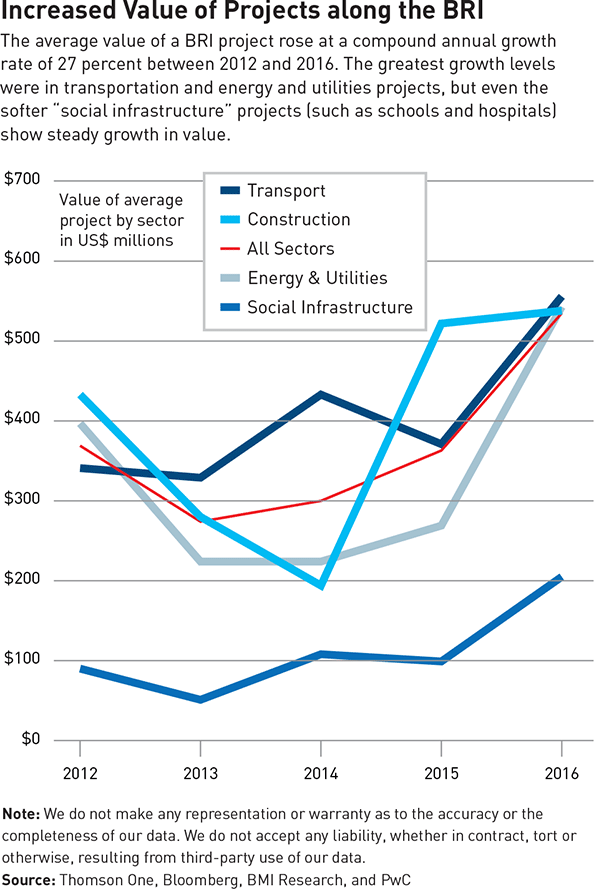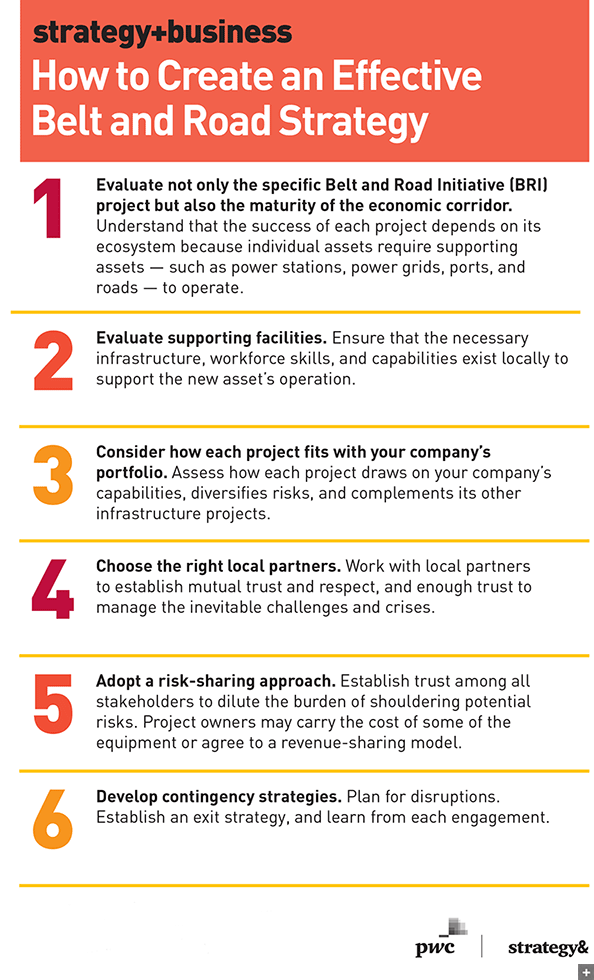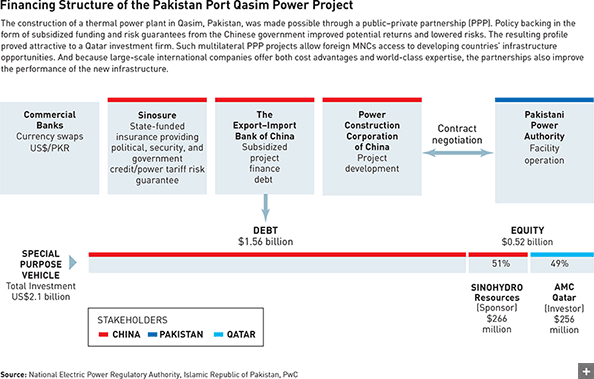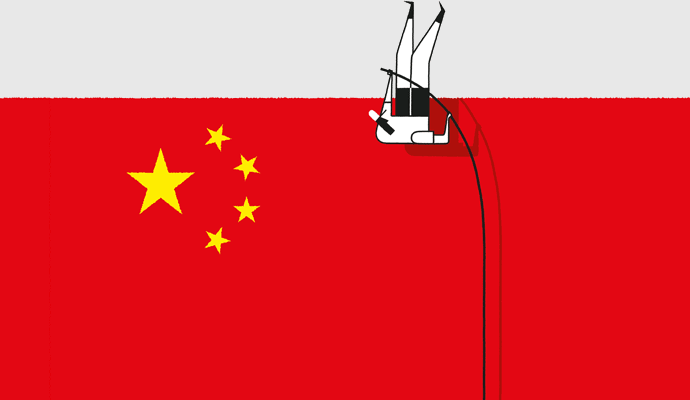A Strategist’s Guide to China’s Belt and Road Initiative
A new global megaproject, unparalleled in scope and ambition, presents vast opportunities and risks for multinationals.

As of early 2018, a new elevated railway in Hanoi is giving commuters a smoother journey into the city. The 13.5 kilometer (8.4 mile) line, which snakes across the Vietnamese capital’s shimmering West Lake, is one element of a much larger rail project that will connect the landlocked Yunnan Province in China directly to the northern Vietnamese port city of Hai Phong, providing access to markets in Southeast Asia and beyond.
Many time zones to the west, the London suburb of Barking has the distinction of being the first English town with direct rail access to China. In January 2017, it welcomed the arrival of a freight train that had traveled 12,000 kilometers (7,500 miles) from eastern China’s Zhejiang Province, with a cargo of garments and handbags. The so-called “East Wind” train made history by retracing part of the ancient Silk Road that more than 2,000 years earlier had linked northern China to the Mediterranean. The railroad traversed Kazakhstan, Russia, Belarus, Poland, Germany, Belgium, and France on its journey to Britain. But it should not be regarded as a pure U.K.-to-China transport link. Once fully operational, it will pick up and drop off goods at many countries in between, thereby opening up parts of Russia and Central Asia that have never before had this type of entrée to the global economy.
These rail projects, which share the same visionary origin, are just two of dozens of road, rail, port, and power generation plans within China’s much-vaunted Belt and Road Initiative (BRI). Formerly known as One Belt, One Road, this vast, interconnected infrastructure project spans at least 65 countries with a combined population of 4.4 billion and about a third of the world’s economic output.
The plan is notable not just for its scale, but for its time frame. Its first phase focuses on infrastructure development, specifically in transportation, communications, and power. The second phase will involve softer sectors such as e-commerce, healthcare, education, and financial services. The first projects are just starting now, and the whole initiative is not expected to conclude until at least 2050.
Already, the rail elements of the plan alone rank as one of the biggest infrastructure pushes ever undertaken. The total estimated value of its 18 planned Chinese high-speed rail projects — of which five are under way — comes to US$143 billion, according to calculations by the Center for Strategic and International Studies, a U.S. think tank, and the Financial Times. That is larger than the U.S.-led Marshall Plan, which spearheaded the revival of Europe after World War II and cost about $130 billion in today’s money. Indeed, compared with the BRI, the Marshall Plan was modest in its ambition: It sought to rebuild the old, war-torn economies of Europe. The BRI is focused on developing new economies around the world, and fostering global trade among them, not just with China.
Moreover, the BRI represents a multistage conception that goes beyond basic capital investment. It will eventually embody leading-edge digital technologies such as embedded sensors and data analytics, thereby giving participating countries the ability to leap past current Western supply chain practices. In doing all this, the BRI could spark a 21st-century expansion of global economic growth, technology exchange, and, inevitably, Chinese influence.
The BRI is not the only comprehensive initiative of this sort emerging in the 21st century, however. Industry 4.0 initiatives from Germany and cloud-based platforms from the United States may eventually interface with it, compete with it, or both. But the ambition and scope of the BRI are even greater than those of its international counterparts. That’s why it is such an important — and complex — strategic opportunity for global enterprises. China has invited companies from other countries to do business with the BRI by investing their financing, technology, or other forms of capital. These investments may give them access to barely tapped markets destined for future growth, while cementing a better foothold in China itself. The relationships companies build with their Chinese partners, including host companies from countries along the BRI pathways, could lead to many opportunities in China and around the world.
Pursuing the Chinese Dream
With all these uncertainties at play, an assessment of the best strategy for your company must start with an understanding of China’s motivations, capabilities, and limits. The concept for the initiative was first unveiled in 2013 by Chinese president Xi Jinping (see “Historic Roots, Grand Ambitions”). Its goals were reaffirmed in late 2017 at the 19th Chinese Communist Party Congress (the congress is held every five years). There, a reference to the initiative was formally added to the party’s constitution. Along with the elevation of Xi to the status of “core leader” (a title held previously only by Mao Tse-Tung and Deng Xiaoping), there could be no clearer sign of the BRI’s importance to China’s national development.
Historic Roots, Grand Ambitions
In scale and ambition, the Belt and Road Initiative (BRI) has no direct precedent. But it does trace back more than 2,000 years to the grand vision of the ancient Silk Road, which forged trade links between China during the Han dynasty and the heart of Europe and the Mediterranean.
The original Silk Road marked the beginnings of commercial relations between China and the Western world from ancient through modern times. To be sure, the amount of trade along this route significantly diminished in the early 1200s, after the fragmentation of the Mongol Empire. But the Silk Road was still robust enough for Marco Polo, who chronicled his journey to China on it in his memoir, completed in 1299. And the route was still in use in the 19th century; indeed, the term Silk Road was coined in 1877 by German geographer Ferdinand von Richthofen.
The BRI’s story began in 1999, when the Chinese government made a concerted effort to promote overseas Chinese investments with its “Go Out” policy: This was a mandate to Chinese companies, demanding they invest and operate outside China’s borders whenever possible. The country’s leadership understood that they could not rely on growth from domestic markets alone. Led by its state-owned enterprises, China’s overseas investments rose from $3 billion in 1991 to $35 billion in 2003. During this time, the Chinese government signed bilateral agreements to collaborate in financing and developing infrastructure in many developing countries.
In September 2013 — about a year after he became secretary-general of the Communist Party and six months after being elected president — Xi Jinping proposed the overland component, the Silk Road Economic Belt, during a trip to Kazakhstan. He announced the Maritime Silk Road on a trip to Indonesia a few weeks later. These two efforts culminated in the announcement of the formal initiative in May 2014, at the Conference on Interaction and Confidence Building Measures in Asia.
Following this, the Chinese government established national policies under the name One Belt, One Road. It realigned existing outward-focused projects and adjusted bilateral agreements and memoranda of understanding. New projects soon followed. The initiative, renamed the Belt and Road Initiative in 2016, isn’t always consistent. Chinese statements about new undertakings don’t always mention a Belt and Road linkage. But with any new Chinese project outside the country’s borders, there is an implicit expectation that it will fit somehow with the Belt and Road.
The BRI plan aims to build out the overland and maritime infrastructure needed to create a broad web of new trade connections from the Eastern hemisphere to the West. It will do so by developing six broad economic corridors. Four are predominantly land routes connecting China to Europe through Central Asia. For example, a New Eurasian Land Bridge economic corridor is intended to be a major logistics passageway between China and Europe with transcontinental rail connections, including that China-to-London freight train that ended its journey in Barking. The two remaining corridors are maritime routes, establishing land–sea connectivity across Southeast Asia, South Asia, the Middle East, and Eastern Africa.
The BRI’s goals are multipronged. The initiative will provide markets to absorb China’s industrial over-capacity and facilitate trade with and between participating countries, while also potentially strengthening China’s diplomatic relations across its six economic corridors. It could also help internationalize the renminbi. Finally, it will enable China to gain global recognition in developing complex transnational infrastructure projects, such as high-speed rail networks.
The initiative will establish a greater capability among Chinese companies for building, innovating, and maintaining infrastructure around the world, ensuring that more of them will be profitable outside China’s borders. A specific recommendation on this issue has been made by the Center for China and Globalization, a Beijing-based think tank that works on the BRI. The center said in a May 2017 paper that China should prioritize the construction of overseas industrial parks, as they could help Chinese companies abroad increase exports.
Like China’s growth over the past 20 years, the Belt and Road Initiative will continue to surprise observers.
But the most remarkable aspect of the initiative is not its impressive scale, scope, technology, or level of investment. Rather, it is the challenge that China’s leaders have set themselves in building what Xi has called “a big family of harmonious coexistence.” In its previous large-scale multinational endeavors, China provided overseas funding and construction on a project-by-project basis. The BRI represents a holistic approach, designed to kick off a giant self-reinforcing circle of rising prosperity, investment, market development, and technological advance — all helping to burnish China’s credentials as a global power.
Indeed, many BRI projects are designed for geopolitical as well as commercial impact. In 2010, the Arabian Sea port of Gwadar, in Pakistan, was in complete disrepair. The China Overseas Ports Holding Company, a Chinese state-owned enterprise (SOE), took over operations of the port in 2013 and rebuilt the terminal, in return for a 43-year lease, signed in 2015. The port is now expected to handle more than 400 million tons of cargo a year, much of it carried from China along new highways.
Commercial infrastructure of this sort will also expand markets for Chinese goods and services, providing outlets for the country’s massive industrial overcapacity and its workforce. Construction of railways, pipelines, and other projects could boost steel demand by 150 million tons and keep Chinese mills — many of them currently operating at a loss — running for years, according to Australia-based mining company BHP Billiton.
The initiative may also invigorate Chinese stock markets. According to a PwC research project presented at the annual meeting of the International Business Leaders Advisory Council in 2017, about 235 of the 2,000 largest private companies in the world are located in 11 emerging economy countries along the Belt and Road routes.
Finally, for China, there is a strong potential payoff in political stability. Improved infrastructure and a steadily growing regional economy increase the odds that China’s neighbors — and other countries in its potential sphere of influence — will be primarily oriented toward peace and prosperity. China does not want political and economic instability on its western and southern borders. By enhancing the standard of living of other countries, China is creating new markets for all to trade with, not just China.
Many countries along the path are already counting on the BRI to be a catalyst for their own economic growth. Some of the higher-potential developing economies, such as Indonesia, Thailand, and Pakistan, expect to gain new market access for their enterprises through increased trade with other Belt and Road countries. And just about all the countries on the route expect to benefit from the infrastructure investment; the BRI will finance and build desperately needed transportation, water, communication, and power systems. The Asian Development Bank estimates the total infrastructure investment needs in Asia to be $1.7 trillion per year at least through 2030; the power and transport sectors will require the greatest investments. Spending of this sort will have a multiplier effect that should accelerate development in many BRI countries.
A Tall Tree Attracts the Wind
Largely because of its scale, a major strategy such as the BRI inevitably finds itself having to navigate numerous obstacles. As the Chinese saying goes, “A tall tree attracts the wind.” Many commentators see the project as an effort to gain advantage and global leverage at the expense of geopolitical rivals, such as the U.S., India, and Germany. The same concerns that have been expressed in the past about investment in China — limits on access to lucrative markets, forced partnerships with Chinese companies, pressure to yield technological knowledge and intellectual property, and restrictions on information flow — have also been raised about the Belt and Road Initiative.
However, we believe some commentary has been too quick to narrowly label the BRI as a purely geopolitical play by China intended to strengthen its influence across East Asia and Central Asia. There are also signs that China’s state-owned enterprises are changing their behavior. The association of the BRI with “Xi Jinping thought” suggests that Chinese companies are being encouraged to focus on quality growth and profitability, not just growth at any cost. Furthermore, the BRI’s association with global funding entities such as the World Bank and the Asian Development Bank demonstrates its commercial focus.
The crucial question of funding is answered only in part. The Chinese government has allocated huge sums to BRI projects. Major funding sources such as the Silk Road Fund and policy and commercial banks have committed to financing $186 billion, as of 2016. At a BRI summit in China in May 2017, Xi announced the expansion of the Silk Road Fund by $14.8 billion, in addition to its starting capital of $40 billion. Policy banks are also setting up BRI multicurrency special lending schemes totaling about $56 billion.
Yet even this will not be enough to cover everything. China is actively seeking partnerships with foreign companies because, owing to domestic financial constraints, it cannot afford to fund all these BRI projects on its own. More than 600 million Chinese people still live below “middle income” status, and the indebtedness of Chinese corporations and provinces looms as a significant issue.
We believe this has profound — and positive — implications for the BRI: China not only needs but, at a policy level, wants the BRI to show commercial returns as soon as is practically possible. This means that there is significant potential alignment between the objectives of China and those of foreign companies and investors as they look to get involved.
Opportunities for Foreign Companies
The projects within the first phase of the BRI, which focuses on infrastructure development, will act as the keystones for much wider ecosystems that will present later opportunities for other, more consumer-focused sectors such as education, healthcare, retail, and financial services. We see six key ways foreign companies can participate in the first phase.
1. As investors. Companies can invest in bankable infrastructure projects, either by co-investing with Chinese players or by investing in partnership with existing Chinese instruments, such as the Silk Road Fund. The Chinese government has thus been seeking foreign investment, in part through its infrastructure bonds. In August 2015, the China Construction Bank listed its first RMB1.0 billion (US$152 million) Belt and Road infrastructure bond on SGX, the Singapore exchange. In May 2017, the Bank of China’s Singapore branch issued bonds worth US$600 million to support the Belt and Road Initiative. Commercial banks are being invited to participate. The right terms for both bilaterally funded and privately financed projects will need to be carefully negotiated.
2. As suppliers. Companies can supply advanced construction equipment, machinery, and cutting-edge solutions for infrastructure projects, for which there has already been much collaboration between Chinese companies and foreign multinationals. In addition to suppliers of construction materials, those specializing in providing equipment can expect to get involved. If your company possesses specialized infrastructure equipment, for example, it could support Chinese engineering, procurement, and construction (EPC) projects overseas. In Turkey, the Swiss ABB Group has worked with China’s first railway equipment manufacturing company, CRRC Tangshan, and provided tailor-made traction motors for the metro project in Turkey.
3. As partners in EPC. If a company has recognized international experience in large-scale infrastructure projects or in dealing with local EPC companies of the BRI countries, it could partner with firms from China by sharing their experiences in designing and developing infrastructure in less developed countries. Partnerships like these can enable a company not only to gain access to new markets along the Belt and Road routes, but also to gain credibility with Chinese companies that can help with access to the Chinese domestic market. Mexico’s CEMEX has partnered with CBMI Construction and China National Building Materials Group Corporation in a number of overseas ventures along BRI corridors. The cement company signed a contract in June 2017 with CBMI to build a new kiln production line in the Philippines, with an overall capacity of 1.5 million metric tons of cement.
4. As experts in international project management. A company can share its expertise, especially in working with complex, large-scale BRI projects in remote locations, which requires managing multiple stakeholders. Chinese SOEs in particular will need advice and guidance on how best to navigate local laws, regulations, and business environments, as well as how to work with local players and workforces. There may be more in-depth partnership opportunities for companies that specialize in professional services and project and commercial management. Some companies, traditionally providers of infrastructure, are already creating advisory services that will enable them to confer and provide project management services based on their core capabilities. U.K.-based Amec Foster Wheeler (AFW) has been able to draw upon its expertise in project managing complex infrastructure projects to participate in opportunities along the Belt and Road routes. AFW secured a three-year project management contract with Shenhua Ningxia Coal Industry Group in 2015 to provide engineering, commercial procurement, health and safety, and quality project control services to a coal chemical by-product processing plant.
5. As operators of new facilities and managers of the newly constructed infrastructure. A company can bring its operational experience in managing effectively, profitably, and sustainably to new settings. Beyond technology, Chinese company leaders are interested in management experience, especially within emerging economies. China has strong experience in developing good infrastructure in China, but limited experience in developing similar projects abroad. It is therefore an “away game” for China, which means the country needs help managing stakeholders across multiple regions, where before it has not needed to manage anyone due to the autonomy it has at home. This change could enable a company to favorably position its experience and skills. Dubai Ports World operates 77 land and sea terminals throughout Asia, the Middle East, and Europe, and is expanding into Central Asian markets along the BRI corridors to take advantage of the potential growth in trade. This includes its involvement with operating the Yarimca container terminal in Turkey and in providing advisory services to develop a free trade zone in Azerbaijan.
6. As sellers of assets. Companies can divest assets to enterprises operating along the Belt and Road routes — either Chinese or local companies that are keen to enhance their existing capabilities. Air France has divested 10 percent of its company to China Eastern Airlines, one of China’s largest state-owned airlines. This deal reflects the anticipated increase in transport links between Asia and Europe, as well as the increasing number of Chinese travelers the BRI is likely to bring about. The alliance also provides Air France with a European leadership position in Shanghai, meaning this is a win for both parties.
Managing Risks
As with all endeavors focused on emerging markets, companies will face challenges and potential risks with this initiative, any of which could lead a company to make major investments without sufficient payoffs. First, there are the operational issues associated with any emerging economy, and the risks that come from poor execution. Second, there are risks associated with the high level of trust and commitment needed for a transnational project. Trust at this level can be challenging and time-consuming to establish, but if approached correctly, these investments could encourage local reforms that would attract much-needed foreign investment and participation.
A third type of risk is related to the long gestation periods for capital investment projects. Such projects are thus vulnerable to geopolitical developments: changes in government, policy shifts, and feelings of amity or enmity toward China. For example, in Sri Lanka, a change in the presidency in 2015 caused a yearlong delay in the development by China of a port facility in the capital, Colombo.
Because they often extend through several countries, projects also can get caught up in territorial disputes or regional power plays. Partnerships with state-owned enterprises can reduce the control that companies would otherwise have. Some proposed projects may stall or be canceled for political reasons. Others may lack commercial viability. An MNC’s negotiating clout will reflect the leverage it has built through its skills or unique technologies.
A fourth category of risks is associated with investment exposure, reflecting the terms under which a company lends and invests. The BRI is a debt-financed development initiative. The ability of a host country to repay its loans should always be questioned, especially by private investors. Your investment exposure will also be affected by China’s efforts to build trust with other countries, particularly those whose skepticism is based on previous interactions. In November 2017, Pakistan decided to withdraw from a $14 billion project to build the huge Diamer-Bhasha dam — a key element of China’s engagement with Pakistan — reportedly because of Islamabad’s unwillingness to accept the deal’s financial conditions. That same month, Nepal abandoned a $2.5 billion hydroelectric dam with Chinese state-owned company China Gezhouba Group, citing a lack of an open tender process.
Although these were clearly setbacks, we believe such developments demonstrate that countries receiving Belt and Road funding have the ability to push back on terms, regardless of how much investment China is willing to make up front. They also show how China is still perfecting its international engagement model. Chinese state-owned enterprises are intent on improving their capabilities and internal procedures. This should enable them to assume more central contractor roles in BRI projects. Even so, they have much to learn, and will benefit from guidance from other companies with more international experience. The lessons they learn will enhance the potential for the BRI to be a long-term success.
Stepping onto the Road
Against these risks, balance the immense potential reward. The overall context suggests optimism. Already, the average project value of the transport, construction, and energy and utilities sectors has risen significantly since 2015 (see chart below).
As with China’s mainland markets, Belt and Road activity typically starts as a joint venture with a Chinese company. Non-Chinese partners are sought after not just for their technological capabilities, but for their management expertise, especially for complex projects with multiple partners, in remote locations, across several territories. These are attractive projects: They have significant Chinese financing and they are being driven by SOEs, which enjoy strong political support, helping address potential political and financial risks. But it is worth noting that partnering with a Chinese SOE in China is different from partnering with one on a project outside China, where it has less autonomy.
Clearly, the companies that will profit most from participating in the BRI will be those with a focused, long-term strategy designed to give them leverage — a strategy based on a few distinctive, highly competitive capabilities. Such a company, within the BRI, is building a relationship, perhaps leading to a small win to gain trust, understanding, and credibility. It can then position itself to be invited into situations where price is less of an issue. Next, it can protect its interests by making itself indispensable. The company will need to place sharply defined boundaries around its intellectual property, guarding against theft through cyber-attack; at the same time, it should foster a high level of interoperability and collaborative innovation. It builds good relationships, not just in China but along the BRI path, with companies and governments. To build these relationships, it may need to hire and deploy senior people who already have personal connections in countries along the BRI path. And it has to be flexible and engaged enough to learn from experience, because, with this scope and complexity, very little will go precisely as planned. (See “Is Your China Strategy Ready for Anything?” by John Jullens).
At the outset, a few principles may help companies pursue an especially effective BRI strategy.
Evaluate not only the specific BRI project but also the maturity of the economic corridor. The BRI is a network of regional infrastructure projects, each of which is an ecosystem of development. However, the pace of development for each part will differ. For example, energy plants must be linked to pipelines, and ports to roads, for benefits to any part to be fully realized. The political and commercial benefits from infrastructure development can be fully attained only if the transport corridor develops into a true economic corridor, involving, for example, the building of “multimodal linkages” that help increase trade.
When DHL Global Forwarding extended its multimodal service via the trans-Kazakh west corridor between Shenzhen, China, and Minsk, Belarus, in 2017, it deliberately chose such a context. Its latest route covers new overland connections to several major cities along the Belt and Road routes, and is the first regular rail service connecting Shenzhen to Minsk in less than 12 days. The new route supports rising trade with Baltic states and Nordic countries in addition to other major European destinations such as Warsaw, Hamburg, and Tilburg.
Evaluate supporting facilities. BRI projects are increasingly structured under a build–operate–transfer (BOT) model, wherein the company that builds the infrastructure also operates it, at least for an agreed-upon period. This makes any deal more lucrative, but only if the necessary local support exists. Companies must look closely at the local infrastructure, ancillary facilities, and workforce skills before they commit. Many project leaders have learned this lesson the hard way. Certainly conditions have improved in most countries along the Belt and Road, but a company that oversees operations may be responsible for ensuring it has all the support it needs.
Consider how each project fits with your company’s portfolio. Assess how each project draws on your company’s capabilities, diversifies risks, and complements its other activities. Australia’s Aspire Mining and its subsidiary Northern Railways sought and won a contract in February 2017 to build and operate a 546-kilometer railway in Mongolia. It linked the Mongolian city of Erdenet to a large coking coal project that Aspire is developing.
Choose the right local partners. Continually develop your company’s acumen at working with local partners; work to establish mutual trust and respect, and enough flexibility to manage the inevitable challenges and crises. A partner with experience in working with the local government and proving itself in difficult situations will show itself to be a worthy one when disruptions occur. When it financed the Shahjibazar power plant in Bangladesh, HSBC worked closely with two major Chinese banks: the Industrial and Commercial Bank of China and the Export–Import Bank of China, along with the China Export and Credit Insurance Corporation (known as Sinosure) and the Guangdong Power Engineering Corporation. From the beginning, there was an emphasis on in-depth dialogue and strong direct working relationships with individuals in the stakeholder organizations. This made all the difference in that complex financing deal. In other words, it pays to have a good understanding of your partners’ financing arrangements in advance.
Adopt a risk-sharing approach. Specific measures designed to share risk might include waiving the need for performance bonds, having project owners carry the cost of some of the equipment on their books, and establishing a revenue-sharing model, in which the host government provides more support when revenue is low and gains a higher percentage when revenue increases. One such project, involving a multilateral public–private partnership financing model, was the construction of a thermal power generation plant in Qasim, Pakistan, organized by the Chinese state-owned enterprise Sinohydro. Qatar’s Al-Mirqab Capital took a 49 percent stake in the project; the majority share (51 percent) was backed by Sinosure. (These two companies channeled investment from the multiple banks and investment firms involved.) Typically, Sinosure demands a higher percentage of financing to be from Chinese sources; in this case, as “Financing Structure of the Pakistan Port Qasim Power Project” shows, the sharing of risks between Chinese and non-Chinese sources made the project more profitable for both. That type of arrangement may become common on other Belt and Road projects.
Develop contingency strategies. Plan for disruptions. Figure out an exit when one is needed, and learn from each engagement. Your company may need to establish a robust business case for participation in the BRI, where political returns also play an important role for China. Evaluate whether there is a strong strategic partnership for policy development, whether multimodal linkages are well addressed, and whether your organization will be expected to operate facilities whose management falters. Adoption of a portfolio management perspective builds flexibility that can help allow for agile course corrections, thereby increasing the likelihood that overall enterprise objectives will be met. By conducting commercial viability analysis and establishing a portfolio fit, companies can find clarity in the assessment and selection of projects to which they can contribute effectively.
Companies have reason to be optimistic about the Belt and Road Initiative. Many projects will require operational support long after construction is finished, and deals for acquisition and divestment will undoubtedly emerge. Chinese companies are keen to establish long-term relationships with companies seeking access to the BRI and China markets. There may be competition for the right partnerships with Chinese entities. Ultimately, however it evolves, there is only one certainty about any project as audacious and multifaceted as this one: It will not move in predictable ways. Like China’s growth over the past 20 years, the Belt and Road Initiative will continue to surprise observers. With the right approach and attitude, your company can be part of its enormous wave of growth.
Author profiles:
- David Wijeratne is a partner with PwC Singapore. He leads PwC’s Growth Markets Centre, a global team of experts that helps companies enter emerging markets and grow both within and from them.
- Mark Rathbone is a partner with PwC Singapore. He leads the PwC Asia Pacific capital projects and infrastructure (CP&I) advisory practice, advising public-sector and private-sector clients on complex infrastructure procurement and financing transactions.
- Gabriel Wong is a partner with PwC China. Based in Shanghai, he heads the PwC China corporate finance and CP&I teams. He focuses on equity fund-raising for Chinese companies on government infrastructure projects, and on M&A transaction advisory work.
- Also contributing were Stella Lau, China lead for PwC’s Growth Markets Centre, and Ling Boon Neu, capital projects and infrastructure lead for PwC’s Growth Markets Centre.


